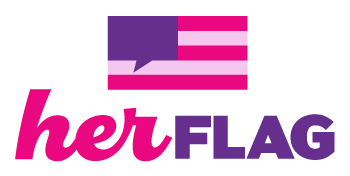24th State to Ratify | Rhode Island | Allison Cole, Artist
Her Flag Artist, Allison Cole
The Rhode Island stripe depicts on the left side six prominent activists from Rhode Island from the suffrage era: Julia Ward Howe, Mary Elizabeth Jackson, Elizabeth Buffum Chace, Mary H. Dickerson, Sarah J. Eddy, and Paulina Wright Davis.
The floral scrolls to the left and right of the Rhode Island text are a reference to the masthead of The Una, one of the first feminist newspapers owned, written and edited entirely by women, founded by Paulina Wright Davis. The modern-day women on the right hold signs, one illustrated with an anchor and the word “Hope” representing the state motto. The banner is flanked with a rising sun on the left and a lighthouse on the right, with a tiny bit of blue ocean at the bottom to represent the landscape of the state.
More background on the women represented:
Julia Ward Howe (1819-1910) was a poet and author, known for writing “The Battle Hymn of the Republic” and also an active abolitionist and women’s suffragist. She was a founding member of the New England Suffrage Association, and later co-president of the American Women Suffrage Association. She lived in both Boston and Portsmouth, Rhode Island.
Mary Elizabeth Jackson (1867-1923) was a suffrage activist and writer. She was a founding member of the Providence NAACP, and wrote for the NAACP’s magazine The Crisis. She is well known for a November 2018 article titled “The Colored Woman in Industry”, which highlighted the working conditions of women in factories. She describes inequality of wages between races and genders as well as poor working conditions.
Elizabeth Buffum Chace (1806-1899) was an activist in the anti-slavery, women’s rights and prison reform movements. Her home in Valley Falls, Rhode Island was the main Rhode Island stop on the Underground Railroad. She founded the Fall River Female Anti-Slavery Society in 1835. After the Civil War, she focused her efforts on securing political rights for women, and became the most prominent female reformer in the state.
Mary H. Dickerson (1830-1914) was a business owner and founder of the Women’s Newport League, later President of the Northeastern Federation of Colored Women’s Clubs. She also served as Vice-President of the National Federation of Afro-American Women. Through her work, she supported community centers, day-care centers, scholarship funds and social uplift for women.
Sarah J. Eddy (1851-1945) was an artist and photographer, as well as an active abolitionist and suffragist, and founding member of the Rhode Island Humane Society. She is best known for her life-size portrait of Frederick Douglass, who sat for the portrait in Rhode Island during the spring and summer of 1883.
Paulina Wright Davis (1813-1876) was an abolitionist, suffragist, and educator. She was one of the founders of the New England Woman Suffrage Association. She helped to organize the first National Women’s Rights Convention in Worcester, MA in 1850, and delivered the opening address. In 1853, she founded The Una, one of the first feminist periodicals owned, written and edited entirely by women.















